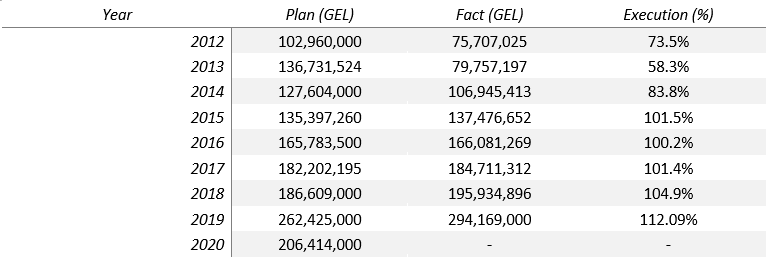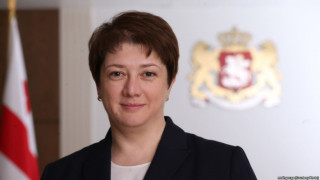Resume: GEL 103 million was allocated to repair-rehabilitate the water supply system in 2012. In 2020, budget assignments for the same purpose constitute GEL 206.5 million which is nearly twice as much as compared to 2012’s figure (by GEL 103,454,000) instead of a tenfold growth as claimed by the Minister. If we compare 2012’s figure to the total sum of the budget assignments in 2013-2020, it does give a tenfold growth in funds for the water supply sector although a comparison of one year’s figure to the total sum of eight years does not make sense. It is only natural that the total funds combined for eight years is ten times more as compared to a single year’s (2012) figure and this fact definitely fails to be a measure of success. This part of Maia Tskitishvili’s statement is far from reality.
In regard to the part about gasification, the amount of people with a natural gas supply increased by 31.6 percentage points according to 2019’s data as compared to 2012, meaning a 1.6-fold increase instead of a two-and-a-half-fold increase as claimed by the Minister. This part of the statement is mostly false. In total, Ms Tsikitishvili’s entire statement is false.
Analysis
The Minister of Regional Development and Infrastructure, Maia Tskitishvili, at a presentation of the sustainable development programme of the Georgian Dream party, provided an assessment of the government’s eight-year work performance and stated (at 22:56): “As compared to 2012, funding for the water supply sector has increased tenfold whilst the gasification volume has increased two-and-a-half-fold”.
Nearly GEL 103 million was allocated to repair-rehabilitate the water supply system in 2012. In 2020, budget assignments for the same purpose constitute GEL 206.5 million which is nearly twice as much as compared to 2012’s figure (by GEL 103,454,000) instead of a tenfold growth as claimed by the Minister. It is unclear what figures Ms Tskitishvili is comparing. If we compare 2012’s figure to the total sum of the budget assignments in 2013-2020, it does give a tenfold growth in the funds for the water supply sector, although a comparison of one year’s figure to the total sum of eight years does not make sense. It is only natural that the total funds combined for eight years is ten times more as compared to a single year’s (2012) figure and this fact definitely fails to be a measure of success.
Table 1: Funding for Water Supply Sector Repair-Rehabilitation Work in 2012-2020

Source: Ministry of Finance of Georgia
In accordance with the National Statistics Office of Georgia, 56.7% of the Georgian population had a home water supply system, 21.7% had a water tap in their yard or on their street, 15.9% had a well in their yard or on their street and 5.6% had a natural spring in their yard or on their street in 2012. In 2019, these figures are 68.8%, 11.9%, 12.8% and 6.4%, respectively. As illustrated by these data, the share of the population with access to a home water supply system increased by 12.1 percentage points in eight years; that is, by 1.5 percentage points annually on average. This is not an impressive figure and does not serve as proof of the Georgian Dream’s particular success in this regard.
The second part of Maia Tskitishvili’s statement is about gasification. In accordance with 2012’s data, 51.2% of the Georgian population had a natural gas supply. This figure was 82.8% in 2019. This means that the amount of people with a natural gas supply increased by 31.6 percentage points in 2019 as compared to 2012, constituting a 1.6-fold increase instead of a two-and-a-half-fold increase as claimed by the Minister.
Given all the aforementioned, Maia Tskitishvili’s statement is ultimately FALSE.







